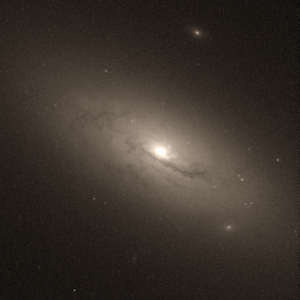NGC 4117
| Galaxy NGC 4117 |
|
|---|---|

|
|
| Photo from the Hubble Space Telescope | |
| AladinLite | |
| Constellation | Hunting dogs |
|
Position equinox : J2000.0 , epoch : J2000.0 |
|
| Right ascension | 12 h 07 m 46.113 s |
| declination | + 43 ° 07 ′ 34.87 ″ |
| Appearance | |
| Morphological type | S0 ^ 0 ^: / Sy2 |
| Brightness (visual) | 13.0 likes |
| Brightness (B-band) | 14.0 mag |
| Angular expansion | 1.8 ′ × 0.9 ′ |
| Position angle | 18 ° |
| Surface brightness | 13.4 mag / arcmin² |
| Physical data | |
| Affiliation | Ursa Major Galaxy Clusters NGC 4051 Group LGG 269 |
| Redshift | 0.003115 ± 0.000005 |
| Radial velocity | 934 ± 1 km / s |
|
Stroke distance v rad / H 0 |
(44 ± 3) x 10 6 ly (13.4 ± 0.9) Mpc |
| history | |
| discovery | William Herschel |
| Discovery date | February 6, 1788 |
| Catalog names | |
| NGC 4117 • UGC 7112 • PGC 38503 • CGCG 215-029 • MCG + 07-25-027 • 2MASX J12074608 + 4307352 • GC 2729 • H III 708 • h 1091 • NSA 60658 • HOLM 334A • LDCE 867 NED075 • WISEA J120746. 11 + 430734.9 | |
NGC 4117 is a lenticular dwarf galaxy with an active nucleus of the Hubble type S0 in the constellation Hounds in the northern sky . It is estimated to be 44 million light years from the Milky Way and about 20,000 light years across. Together with NGC 4118 , it forms the gravitationally bound galaxy pair Holm 334 . It is part of the Ursa Major Galaxy Cluster and a member of the NGC 4051 group ( LGG 269 ).
In the same area of the sky are u. a. the galaxies NGC 4109 , NGC 4111 , NGC 4138 , NGC 4143 .
The object was discovered on February 6, 1788 by the astronomer William Herschel using an 18.7 inch telescope .
Web links
Commons : NGC 4117 - collection of images, videos, and audio files
